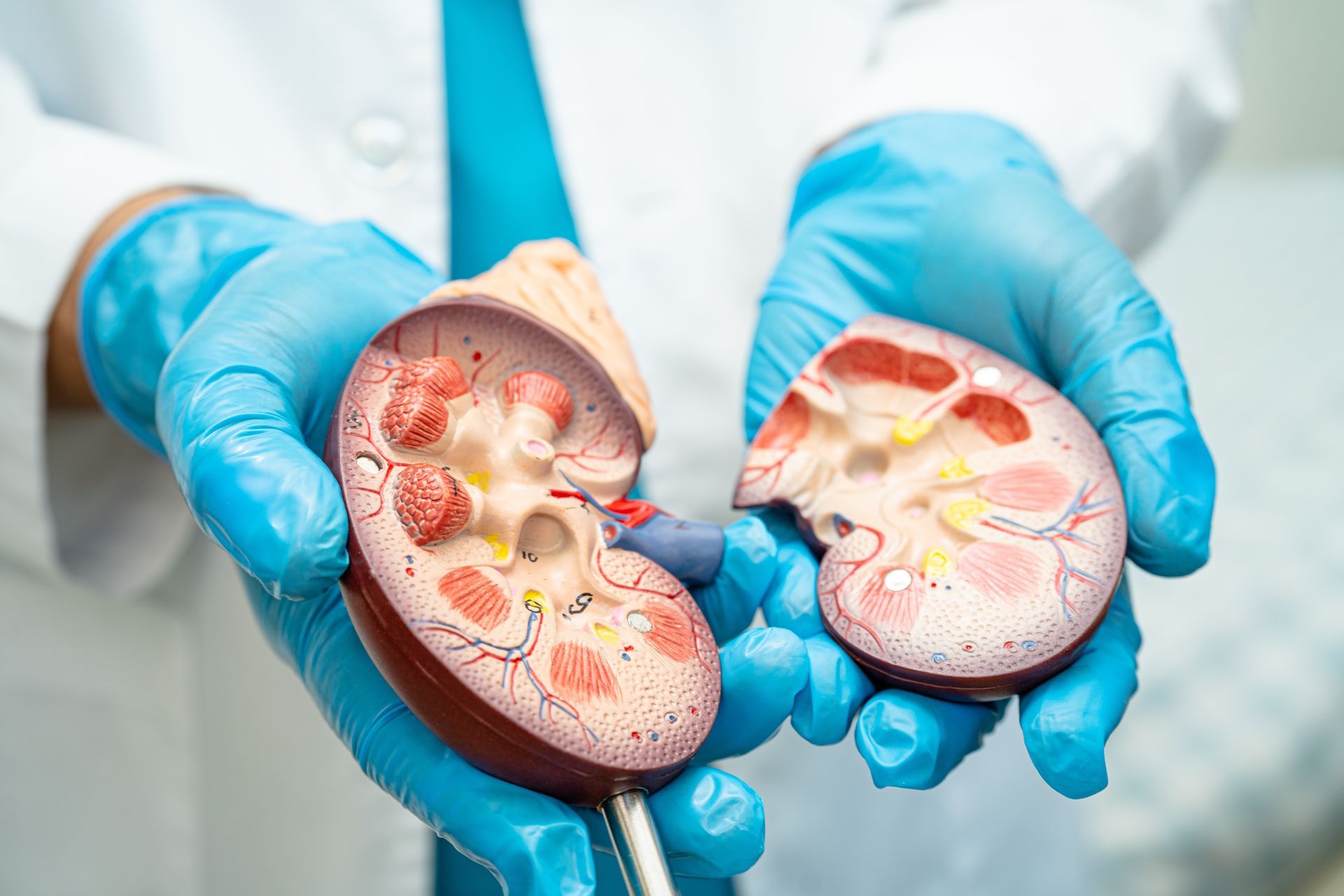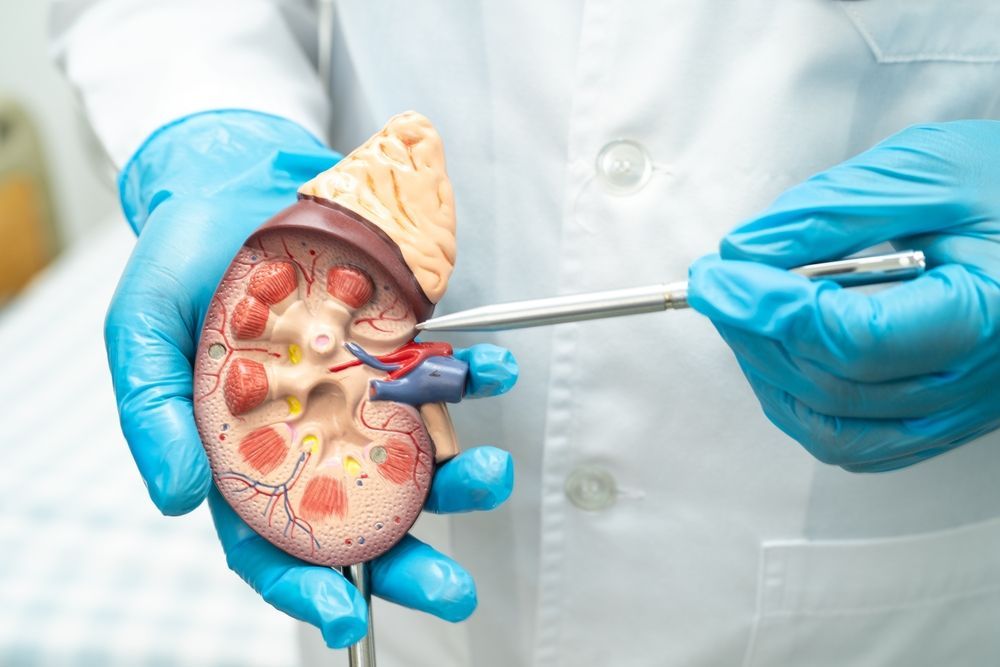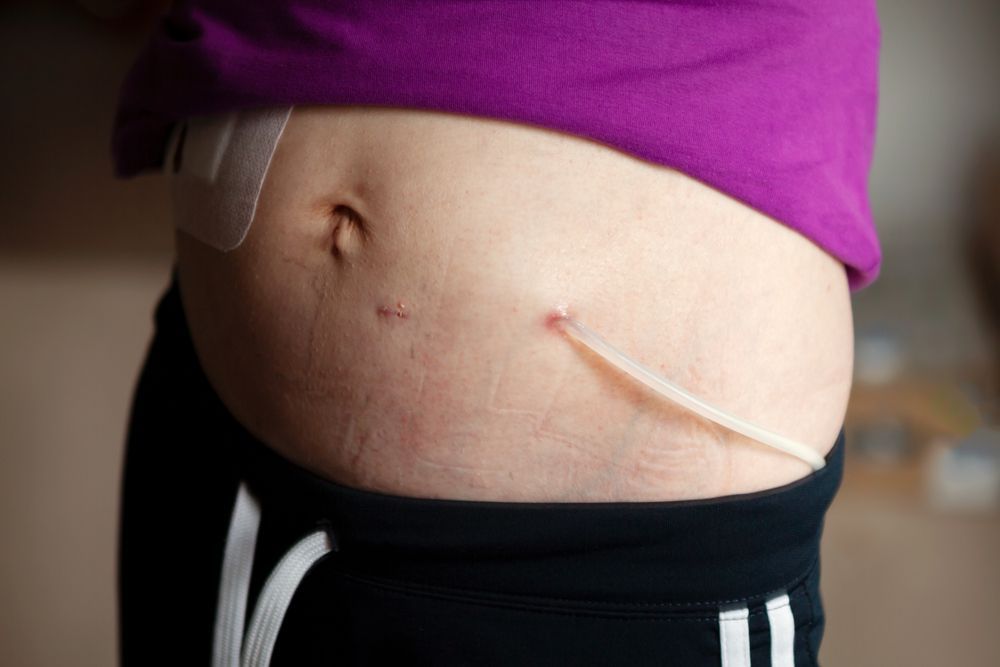Types of Dialysis and How They Work
Share this Article:

Dialysis is a vital medical procedure that steps in for the kidneys when they cannot function, either because of injury, late-stage chronic kidney disease, or kidney failure. Although dialysis cannot replace everything that the kidneys do, it can keep patients with kidney failure alive and give them a good quality of life, even for many years, until a kidney transplant becomes available. Different types of dialysis are available for various patients with a range of medical situations and lifestyle considerations.
Who Needs Dialysis?
Dialysis is essential to preserve the lives of patients who are near or at the final stage of chronic kidney disease: end-stage renal failure. Like the kidneys, dialysis filters and cleans the blood, removing waste products, excess fluids, and toxins that would otherwise build up in your bloodstream. Without this filtering process, a person’s blood would become so toxic that the patient would die within days. When the kidneys cannot perform this vital function, dialysis is required.
Main Types of Dialysis
There are currently two main types of dialysis: hemodialysis and peritoneal dialysis, each named for the pathway used to clean and filter all of a person’s blood supply. Under the umbrellas of these two types of dialysis, different methods and techniques are designed to help patients with various medical needs and daily life considerations. You and your nephrologist will discuss which type of dialysis would work best in your situation.
Hemodialysis
During hemodialysis, vascular access is established through which your blood will be gradually fed from your body through a dialysis machine, and then back into your body after the machine filters and cleans the blood, removing excess fluids and adding back essential electrolytes. This machine is called a dialyzer. Hemodialysis cleans the blood while also helping maintain a healthy blood pressure and a correct balance of sodium, potassium, and other chemicals.
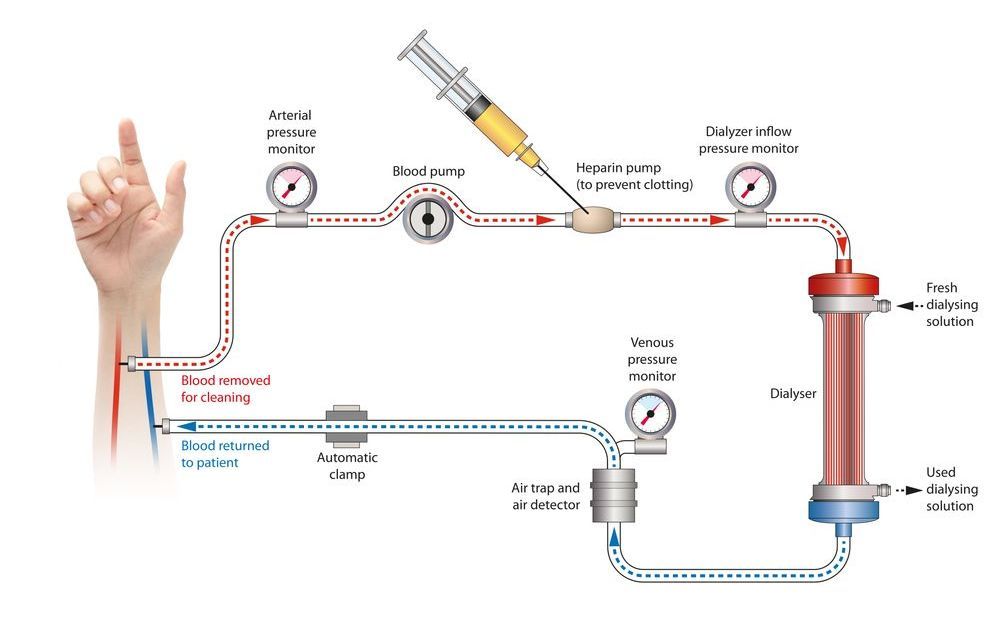
How it Works
Before hemodialysis can be performed, minor surgery establishes a vascular access point, most often in the arm, but sometimes in other parts of the body. This establishes a direct connection point between a vein and an artery so the blood can flow out of the body, through the dialyzer, and then back into the body after it’s been filtered, cleaned, and rebalanced. The dialyzer will be connected to the patient through this point during every dialysis session.
Most patients require dialysis three to five times weekly, on a regular schedule. Each dialysis appointment can last from three to four hours. In the past, patients had to travel, sometimes long distances, to go to a dialysis center to receive treatment. Today, hemodialysis can be performed at home with proper training, equipment, and support from your home dialysis support team.
Key Considerations
- Hemodialysis treatments take a considerable amount of time, several times a week, for a few hours each time.
- It can take time to establish vascular access for hemodialysis. Your nephrologist will discuss this with you if you are under ongoing observation for chronic kidney disease.
- The treatment itself can make you tired, and you will likely need to schedule a friend or family member to take you to and from appointments if you go to a clinic for dialysis.
- Receiving treatment in a clinic or healthcare setting means adding travel time and expenses to treatment time, which can be difficult for many patients.
- Home hemodialysis can save patients time and travel expenses, giving them more control, comfort, and convenience over their treatment process.
- Home hemodialysis can also be performed overnight while you sleep, which is easier on the body and the schedule.
Peritoneal Dialysis
Peritoneal dialysis (PD) also filters the blood when the kidneys cannot, but it uses a different mechanism. This method cleans the blood by inserting a soft catheter tube into the abdominal cavity and filling it with a dialysate solution that uses blood vessels in the peritoneum (the abdominal cavity lining) to filter and clean the blood.
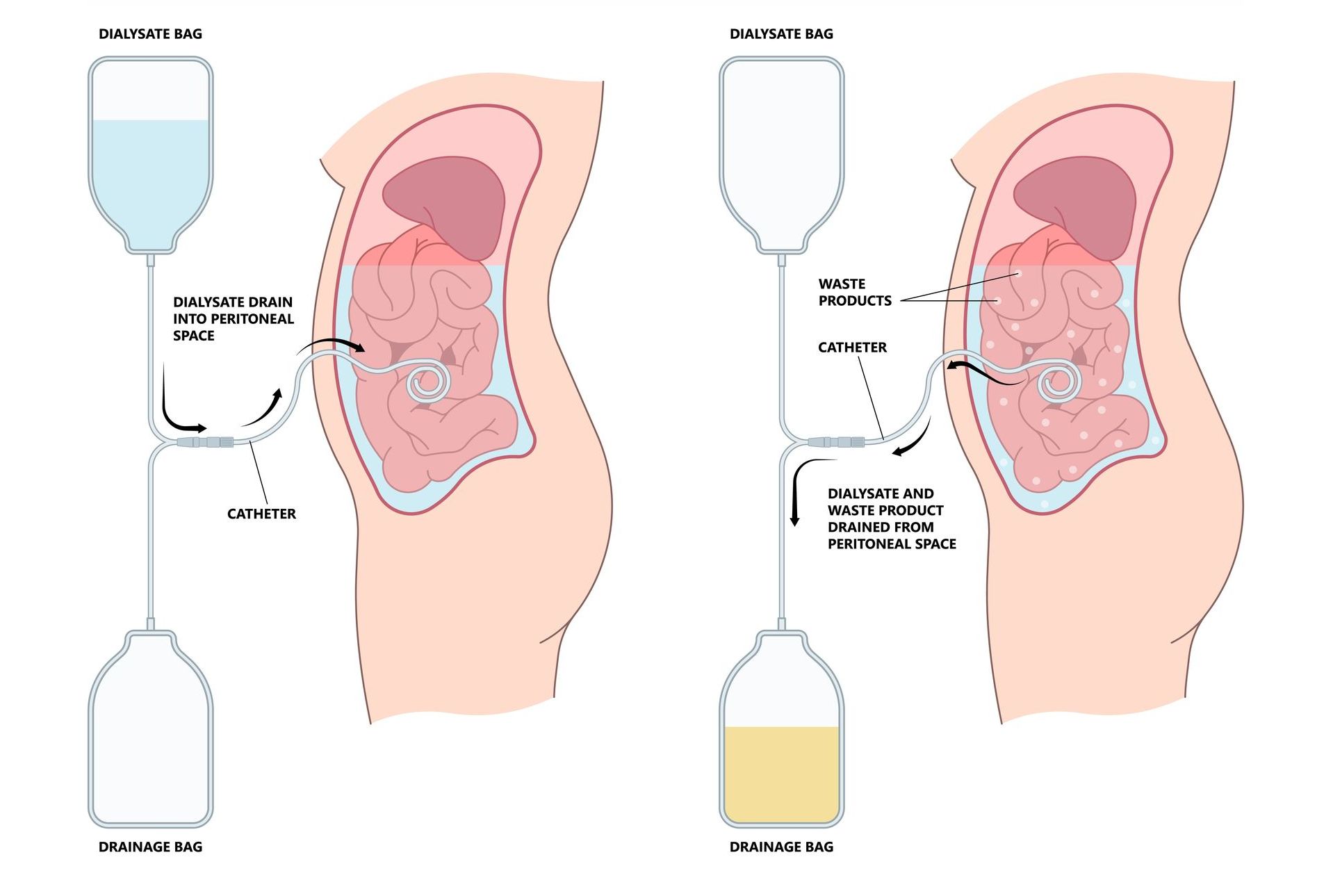
How it Works
A minor surgical procedure will insert the soft catheter tube into the body, where it can access the peritoneum. Once the catheter site is healed, it is ready for dialysis. The dialysate solution filters into the abdominal cavity, cleans, filters, and balances the blood’s fluid and electrolyte levels. The spent fluid then drains out into a bag and is discarded. Each peritoneal dialysis session is called a “cycle” or “exchange”. This process can be done throughout the day while a patient is going about most of their business. With training and equipment, patients can perform PD on themselves at home, typically a few times to several times a day, or even overnight, depending on their needs and their nephrologist’s recommendations.
Key Considerations
- Peritoneal dialysis can be a more flexible, portable option for patients, and it provides more movement independence.
- PD cycle exchanges can be done at home.
- Patients must follow strict hygiene practices to keep the catheter site sanitary to avoid infection.
- Swimming can be tricky with PD: although it isn’t completely contraindicated, the catheter and its exit site should not be submerged in a bath or when swimming or bathing. Patients should never swim in lakes, ponds, rivers, or public pools where bacterial infections could occur.
- Patients will need to devote time and energy to exchanges and maintain and keep their equipment and supplies sterile.
Other Forms and Emerging Dialysis Options
Underneath these two umbrella types of dialysis, there are different modes of delivery, including dialysis in a healthcare setting, overnight dialysis, and home dialysis. As medical treatments and technologies advance, new, emerging forms of dialysis are becoming available that can make life easier for a wider variety of patients. One example of an emerging dialysis option is continuous renal replacement therapy. This option is especially helpful for patients whose bodies are unable to tolerate the other types of dialysis because it is a slower, more kidney-mimicking process. Continuous renal replacement therapy is gentle and effective, helps control blood pressure, and helps improve fluid management in the body. However, it requires constant monitoring and special equipment, so it can only be done in a hospital setting. This form of dialysis is usually reserved for medically fragile patients.
Overview of Nocturnal Dialysis
Nocturnal dialysis is also a good option for many patients. It is a type of hemodialysis that goes slower as you sleep through the night. Because it filters the blood more slowly, closer to the speed your kidneys would normally process the blood, it’s easier on the body. It can be done at home as well, which makes this a very convenient type of dialysis that gives you more freedom and convenience with how you spend your day.
Portable and Wearable Dialysis Technologies
Several researchers are currently testing new technologies that people can wear and walk around with, like portable kidneys. These new devices, which are still being tested, can be used under both the hemodialysis and peritoneal dialysis umbrellas. As technology advances, these devices are getting smaller, lighter, easier to use, and more portable, with the hope that patients with kidney failure can someday go about a regular day wearing these technologies unobtrusively underneath their clothing. The ultimate goal is to create “wearable kidneys” that function like real kidneys that filter and clean the blood, control blood pressure, and maintain healthy electrolyte and fluid balances in the blood.
Comparing Home Dialysis & In-Clinic Dialysis
Today, kidney patients have a lot more options than they did years ago when the only option was traveling to a dialysis center or hospital for treatment several times a week for several hours. This was once a huge time and financial commitment that significantly impinged on a family’s way of life. Today’s smaller, easier-to-use dialysis machines and techniques make home dialysis an easy, safe choice that improves the quality of life for most patients.
Why Home Dialysis is the Best Choice
Home dialysis is the preferred choice for the majority of patients with kidney failure who need dialysis. After discussing your needs with your nephrologist, you may be cleared to work with a home dialysis team such as Vitality Dialysis. Some of the benefits of home dialysis include:
- Comfort: You can set up a cozy area in your own home where you can rest and receive hemodialysis or training to do peritoneal dialysis at home. You can relax, read, work on your laptop, watch movies, nap, chat with friends, and spend that time the way you want, without traveling and spending gas money over and over again.
- Control: You can choose a dialysis schedule that works within your lifestyle. Although even home dialysis will take time from your busy day (unless you choose nocturnal dialysis), you decide when it happens.
- Convenience: All the training, the dialyzer, and supplies are there in your own home. Vitality Dialysis provides all of these things and checks in with you regularly to make sure all is going well.
- Choice: Working together with your kidney doctor, you can choose what makes the best sense for your health and your lifestyle.
- Confidence: Vitality Dialysis provides all the training and equipment you need so that you and trusted family members can safely and confidently perform your dialysis schedule on your terms.
Vitality Dialysis: Leading the Way in Home Dialysis
If you have been told that you will need to prepare to receive dialysis because of failing kidneys or an ongoing chronic kidney disease (CKD) diagnosis, Vitality Dialysis is here to help you work through all the decisions and questions you have so that you have the best outcome and the best quality of life while on dialysis. We are also constantly monitoring new developments in dialysis that may improve our patients’ lives even further. Our expert, compassionate team is there to support you every step of the way. Contact us today to learn more.
Key Takeaways
- Hemodialysis and peritoneal dialysis are life-saving medical treatments for patients with kidney failure.
- Both types of dialysis can be done at home.
- New dialysis technologies are being discovered and researched all the time.
- Vitality Dialysis is there to help patients get the most comfort, control, and convenience in their dialysis journeys.
Share with Us!


